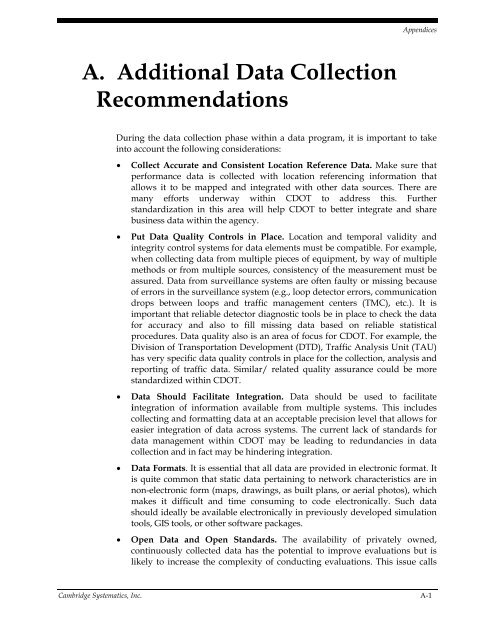CDOT Performance Data Business Plan - Cambridge Systematics
CDOT Performance Data Business Plan - Cambridge Systematics
CDOT Performance Data Business Plan - Cambridge Systematics
Create successful ePaper yourself
Turn your PDF publications into a flip-book with our unique Google optimized e-Paper software.
Appendices<br />
A. Additional <strong>Data</strong> Collection<br />
Recommendations<br />
During the data collection phase within a data program, it is important to take<br />
into account the following considerations:<br />
<br />
<br />
<br />
<br />
<br />
Collect Accurate and Consistent Location Reference <strong>Data</strong>. Make sure that<br />
performance data is collected with location referencing information that<br />
allows it to be mapped and integrated with other data sources. There are<br />
many efforts underway within <strong>CDOT</strong> to address this. Further<br />
standardization in this area will help <strong>CDOT</strong> to better integrate and share<br />
business data within the agency.<br />
Put <strong>Data</strong> Quality Controls in Place. Location and temporal validity and<br />
integrity control systems for data elements must be compatible. For example,<br />
when collecting data from multiple pieces of equipment, by way of multiple<br />
methods or from multiple sources, consistency of the measurement must be<br />
assured. <strong>Data</strong> from surveillance systems are often faulty or missing because<br />
of errors in the surveillance system (e.g., loop detector errors, communication<br />
drops between loops and traffic management centers (TMC), etc.). It is<br />
important that reliable detector diagnostic tools be in place to check the data<br />
for accuracy and also to fill missing data based on reliable statistical<br />
procedures. <strong>Data</strong> quality also is an area of focus for <strong>CDOT</strong>. For example, the<br />
Division of Transportation Development (DTD), Traffic Analysis Unit (TAU)<br />
has very specific data quality controls in place for the collection, analysis and<br />
reporting of traffic data. Similar/ related quality assurance could be more<br />
standardized within <strong>CDOT</strong>.<br />
<strong>Data</strong> Should Facilitate Integration. <strong>Data</strong> should be used to facilitate<br />
integration of information available from multiple systems. This includes<br />
collecting and formatting data at an acceptable precision level that allows for<br />
easier integration of data across systems. The current lack of standards for<br />
data management within <strong>CDOT</strong> may be leading to redundancies in data<br />
collection and in fact may be hindering integration.<br />
<strong>Data</strong> Formats. It is essential that all data are provided in electronic format. It<br />
is quite common that static data pertaining to network characteristics are in<br />
non-electronic form (maps, drawings, as built plans, or aerial photos), which<br />
makes it difficult and time consuming to code electronically. Such data<br />
should ideally be available electronically in previously developed simulation<br />
tools, GIS tools, or other software packages.<br />
Open <strong>Data</strong> and Open Standards. The availability of privately owned,<br />
continuously collected data has the potential to improve evaluations but is<br />
likely to increase the complexity of conducting evaluations. This issue calls<br />
<strong>Cambridge</strong> <strong>Systematics</strong>, Inc. A-1

















